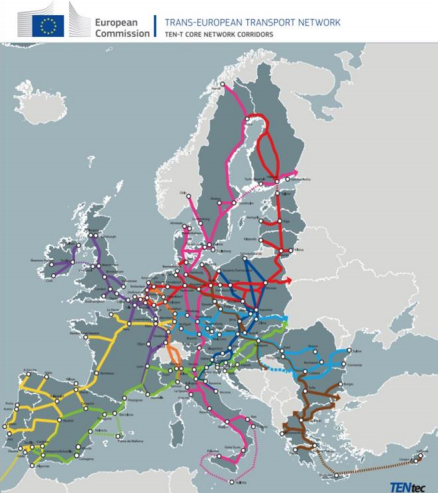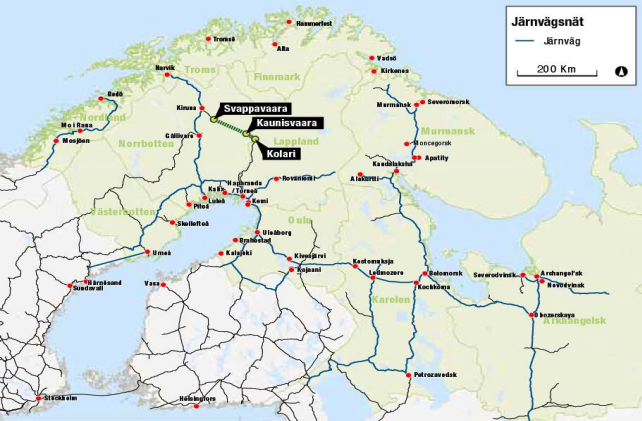Why the TEN-T should be extended to Northern Sweden

The extension of the TEN-T to Northern Sweden will create a strategic EU gateway to the Arctic and consolidate the engagement of the EU as a key player in the development of the Arctic region. This was pledged by Mona Mansour, Senior Adviser European Affairs North Sweden European Office at the RailGate Kouvola conference, held on 26 September in Kouvola, Finland.
As the European Commission DG MOVE has started the revision process of the Trans-European Transport Network, a Europe-wide network including core transport routes, those who would like to see inclusion in this network are making their case. Such is the Scandinavian country of Sweden, the northern part of the country in particular. The region should be included in the TEN-T and thereby be eligible for EU funding instruments to develop the railway network, the stakeholders argue.
Proposal
This idea was formally proposed by the European Commission itself in June 2018, when it presented the proposal for a new regulation for the Connecting Europe Facility (CEF) post 2020. The core network, it suggested, had to be extended by 15 per cent.
For Sweden, currently covered by 40 per cent of the corridor network, it suggested the extension of Scandanavian-Meditarranean corridor (Scan-Med corridor) to Stockholm, Umeå, Luleå and then to the Finnish town of Oulu bending eastwards, while another section being extended to the port of Narvik in Norway.
The North Sea-Baltic Corridor could also be extended from it current most northern point of Riga to Tallinn in Estonia, Helsinki in Finland and finally Luleå in Sweden. The two core network corridors would be aligned at the Swedish-Finnish border of Haparanda/Tornio.
Text continues below the image

Large export region
The proposal is line with the proposal submitted by the Swedish Government and supported by the Governments of Finland and Norway. In fact, the extension is vital to accommodate the export-intensive industries in Northern Sweden, which provide with large volumes of iron ore, forestry and steel products in north-south and east-west directions, says Mansour.
The region has a long tradition of mining and forestry activities. According to the politician, 90 per cent of the iron ore production in the EU is exploited here. “Ore worth of 2,5 billion euros is turned into 55 billion euros of processed raw materials in Sweden before further processing in Europe. Moreover, Sweden, together with Finland and northern parts of Russia, provides substantial amounts of other critical minerals for the European industry, such as copper, gold and lithium as well as the main source of wood for pulp, paper, timber and biomass.”
Text continues below the image

Projects
However, the region does require important infrastructure upgrades, Mansour points out during her presentation in Kouvola. There are several priority projects aimed at facilitating the vital industries of northern Sweden with an even better transport network, preferably enabling a shift to rail at the same time. The Iron Ore Line is being upgraded, as well as the Haparanda Line. While the first runs from Narvik to Lulea in Sweden, the second connects the Swedish cities of Boden and Haparanda, all on the route to Finland.
“The Iron Ore Line should get a double track”, explains Mansour. “The final goal is to ensure a billion tonnes of mineral resources in the next five years. The total production in the first quarter of this year was 6,5 million tonnes, while the volumes delivered amounted to 6,1 million tonnes.
Another project is ongoing on the Bothnia Line, a railway line that currently runs from Höga Kusten Airport to Umeå. This line will be extended with a 270km section to Luleå, thereafter called the North Bothnia Line. “A new double track railway line will close the gap in the missing link in the transport system of Northern Sweden”, explains Mansour. “Every day steel corresponding to one Eiffel Tower from Northern Sweden is shipped to Europe. With the North Bothnia Line we will be able to transport more.”
Text continues below the image

Connection to China
But the upgrades are not only on the north-south transport network. The west-east routes are equally important. “A functioning infrastructure via the Iron Ore Line and Haparanda Line and further towards the Trans-Siberian railway is crucial for European growth and the conditions in a larger Arctic context”, according to Mansour.
With this, she is aiming at a connection to Eurasian corridor which eventually ends up in China and other Asian countries, such as Japan and South Korea. The northern version of this connection is also referred to as the Nordic Silk Road, an extension of the Trans-Siberian railway through Russia, entering Europe at Kouvola in Finland. From here, other Scandinavian destinations can be reached.
But also important in the west-east movement of goods is the Barents Corridor, crucial for the transport of raw materials. A new railway between Pajala-Svappavaara would enable this transport through the western Barents region. “This would facilitate a shift from road to railway: one train can replace 25 timber trucks. The company Kaunis Iron aims at an annual production equivalent to 2 million tonnes of iron ore. Quantities of mineralised material in the deposits amount to roughly 130 million tonnes with an average iron content of 34 per cent, and there is considerable growth potential.”
Text continues below the image

Urgent need
However, the upgrades of these strategic transport lines require funding, the Swedish representatives states. “In order to accelerate funding and implementation of the priority infrastructure investments, is important that the ScanMed corridor is extended to Northern Sweden. The export-intensive industry of Northern Sweden requires good connections to the European market.”
To achieve this goal, the main EU-policy areas addressed are the TEN-T and CEF revision, she explains. “CEF 2.0 entails the extension of the corridor network post 2020, while the TEN-T revision means the development of the network beyond 2030.”
Regarding the first, negotiations currently ongoing in Brussels. As soon the Council reaches an agreement on the Multi-Annual Financial Framework (MFF), trialog meetings are to start thereafter, discussing a new regulation for the period 2021- 2027. Meanwhile, the European Commission has already started the revision process of TEN-T. An open consultation is taking place and next year the commission is expected to carry out further in-depth studies. The regulation proposal for the revised TEN-T should be presented during 2021-2022.

Also read:
From Atlantic to Pacific by rail and still fresh
You just read one of our premium articles free of charge
Want full access? Take advantage of our exclusive offer





